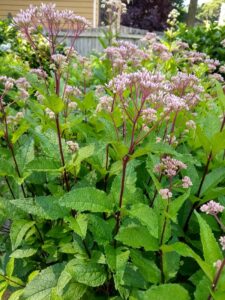 Sometimes I find Joe Pye-weed, or Eupatorium maculatum, annoying. Let me count the ways. First, the North American native plant is vigorous to the point of invasiveness, with a seed germination rate that must be about 150 percent. The wind carries those seeds all over the place, starting new colonies wherever the seeds happen to fall. Second, the plants, left to their own devices, grow to be seven feet tall. This would be fine if I had several acres of meadow garden, but without diligent management efforts, that kind of height tends to overpower a suburban landscape. Third, because of those wayward tendencies, Joe Pye-weed requires extreme vigilance. There is always some chore that needs doing—from grubbing out unwanted seedlings to executing the “Chelsea chop” and cutting back the stems in the months prior to late summer flowering. I have done this “chop” three times over the course of the growing season, and the plants are still four feet tall.
Sometimes I find Joe Pye-weed, or Eupatorium maculatum, annoying. Let me count the ways. First, the North American native plant is vigorous to the point of invasiveness, with a seed germination rate that must be about 150 percent. The wind carries those seeds all over the place, starting new colonies wherever the seeds happen to fall. Second, the plants, left to their own devices, grow to be seven feet tall. This would be fine if I had several acres of meadow garden, but without diligent management efforts, that kind of height tends to overpower a suburban landscape. Third, because of those wayward tendencies, Joe Pye-weed requires extreme vigilance. There is always some chore that needs doing—from grubbing out unwanted seedlings to executing the “Chelsea chop” and cutting back the stems in the months prior to late summer flowering. I have done this “chop” three times over the course of the growing season, and the plants are still four feet tall.
That being said, the other day I stood in the brick circle that is the center of my lower back garden. It was warm and sunny and the Joe Pye-weeds that surround the brick circle were at the height of bloom. The vanilla fragrance emanating from the flowers was intoxicating. A monarch butterfly circled just over my head, picking what it deemed to be the most attractive flowerheads and lighting on them for sips of nectar. The buzzing of all kinds of bees—bumble, honey and many other types—was audible. Skippers, those small butterfly/moth creatures, were also swooping from plant to plant. There was so much life around the brick circle that the whole garden seemed to be pulsating. I stood there for quite awhile, completely forgetting all the lopping, grubbing and other Joe Pye-weed chores. It was tempted to stay in that place for hours.
Eupatorium purpureum is one of a number of Joe Pye-weed species, all members of the vast Compositae or daisy family, and native to parts of North America. Plant taxonomists, who seem to delight in flummoxing plant lovers, have transferred the Joe Pyes to the genus Eutrochia, transforming my Eupatorium maculatum into Eutrochia dubium. I am dubious about that and will continue to use the old Latin name. Most plant vendors are doing the same.
Like goldenrod, another popular native plant, Joe Pye-weed does not look like a typical daisy. The flower clusters, which appear at the tops of the sturdy stems, are corymbs—large flat-topped masses of tiny flowers. Generally they are pink-purple and intensely fragrant. The stems are a dramatic shade of near-black.
Unfortunately, the dark, toothed leaves, which grow in whorls around the stems are not especially attractive, and, in fact, look somewhat weedy as the plant is growing. On the weediness scale, they are less weedy-looking than either non-blooming goldenrod or leggy New England asters, but they are certainly not a source of multi-season interest. The black stems give the plants a bit of drama, but savvy gardeners would be doing the overall landscape a favor by planting lower-growing species in front of the Joe Pyes.
After the blooms are finished, the plants can be cut all the way back to the ground, restoring order after the busy-ness of the bloom season. It is wise to do this, if possible, before the Joe Pyes set seed. If you have a lot of them, some self-seeding will be inevitable, no matter what you do, but you can at least try to limit its scope.
Bird lovers, who don’t mind the self-seeding trait, may allow the seedheads to remain, as they also sustain birds in cold weather.
Is Joe Pye-weed worth the trouble? I think so, because it fills the garden with pollinators at a time when many other plants are taking a rest. Butterflies may rest their wings by alighting on the complicated flowers of my double roses-of-Sharon, but they gorge themselves on Joe Pye-weed. The tall black stems topped by purple-pink flowers glow in the late August/early September light. In fact, all things considered, there is something of a Cinderella quality to Joe Pye-weed.
European breeders were the first to recognize the species’ possibilities and have produced some good hybrids, including ‘Baby Joe’, which has the same lovely flowers on plants that top out at three feet without benefit of repeated “Chelsea chops”. ‘Gateway’ comes in somewhere between the species and ‘Baby Joe’, rising to five feet tall. ‘Glutball’, from Germany, grows to seven feet, but sports darker green leaves with red midribs, adding to its allure before and just after blooming.
If, after due consideration of the pros and cons, you decide to add some Joe Pye-weed to your garden, you can find a good selection at Digging Dog Nursery, 31101 Middle Ridge Road
Albion, CA 95410; (707) 937-1130; www.diggingdog.com.
